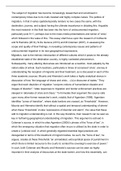Samenvatting
Summary Critical Essay
- Vak
- Instelling
This essay focuses upon the research of A.Mountz and N.Hiemstra (2014), N.De Genova (2013) and M.Coleman (2007), in assessing the scope and quality of their findings, in revealing contemporary issues and patterns of undocumented migration in its new geographical expressions.
[Meer zien]




